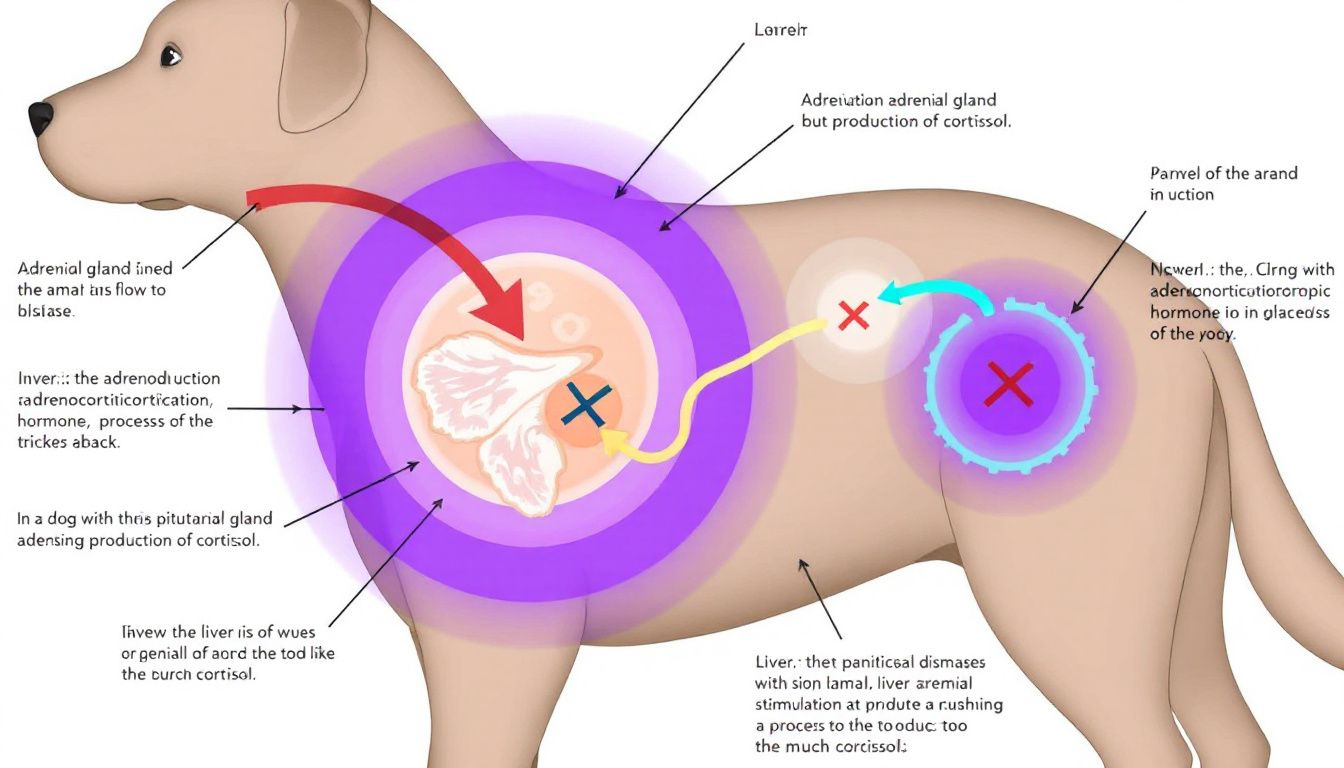Cushing’s disease in dogs happens when the body makes too much cortisol, a vital hormone. This often results from tumors in the pituitary or adrenal glands or from long steroid use. Signs include increased thirst, frequent urination, and a pot-bellied look. This article explains symptoms, causes, and treatment options for what is Cushing’s disease in dogs.
Key Takeaways
-
Cushing’s disease in dogs is caused by excessive cortisol production, resulting from tumors or prolonged corticosteroid use, with symptoms including increased thirst, urination, appetite, and a pot-bellied appearance.
-
Diagnosis of Cushing’s disease involves medical history, physical examination, and specific tests such as blood tests, urinalysis, and advanced diagnostic procedures like ACTH stimulation tests.
-
Treatment options vary based on disease type and severity, ranging from medications to surgery, along with ongoing management and dietary adjustments to maintain the dog’s health.
Understanding What Is Cushing's Disease in Dogs: Symptoms and Treatment
Cushing’s disease, also known as hyperadrenocorticism, is a hormone disorder characterized by excessive cortisol production in dogs cushing’s disease. This condition can arise from benign or malignant tumors located either in the pituitary or adrenal glands, or from prolonged use of corticosteroids. Common symptoms include increased thirst, urination, appetite, and a distinctive pot-bellied appearance. Diagnosing this condition typically involves blood tests and urinalysis to assess hormone levels and potential abnormalities.
Before:
Early detection and treatment of Cushing’s disease hinge on recognizing its symptoms. Dogs with this condition typically show significant changes in behavior and physical appearance. Key indicators include increased thirst, frequent urination, and a heightened appetite. The distinctive pot-bellied appearance, caused by muscle wasting and fat redistribution, is another hallmark symptom.
After:
Key indicators of Cushing’s disease in dogs include:
-
Increased thirst
-
Frequent urination
-
Heightened appetite
-
Distinctive pot-bellied appearance, caused by muscle wasting and fat redistribution
Early detection and treatment hinge on recognizing these symptoms.
The treatment for Cushing’s disease depends on its type and severity, ranging from medications that reduce cortisol levels to surgical removal of tumors. Collaborating with your veterinarian is key to finding the best approach for your dog. Proper treatment can enable dogs with Cushing’s disease to live healthy and fulfilling lives.
Introduction
Cortisol is a crucial hormone in the body, playing a significant role in regulating metabolism, reducing inflammation, and assisting with stress responses. However, when the body produces excessive amounts of cortisol, as seen in Cushing’s disease, it can lead to various health issues. This condition is common in middle-aged to older dogs and does not show a significant gender preference.
Diagnosing Cushing’s disease can be challenging because its symptoms often resemble other health issues. A combination of medical history, physical examinations, and specific diagnostic tests is necessary. Fortunately, effective management is possible through medications and surgery.
What is Cushing's Disease?

Cushing’s disease manifests in various forms, each needing a distinct treatment strategy. For example, Iatrogenic Cushing’s syndrome arises from excessive steroid use. Common symptoms across all types include increased thirst, frequent urination, a heightened appetite, and a pot-bellied appearance.
Accurate diagnosis and appropriate treatment are vital for managing this serious health condition effectively to regain normal health.
Common Causes of Cushing's Disease in Dogs
The most common cause of Cushing’s disease in dogs is a tumor on the pituitary gland, accounting for 85%-90% of cases. These pituitary tumors can lead to increased production of ACTH, which stimulates the adrenal glands to produce excessive amounts of cortisol. Adrenal tumors, whether benign or malignant, represent another cause, albeit less common, accounting for about 10-15% of cases.
Iatrogenic Cushing’s disease, on the other hand, arises from the excessive administration of corticosteroids. These steroids, often used to treat other conditions, can inadvertently lead to iatrogenic Cushing’s disease if not monitored carefully. Recognizing these causes aids in both preventing and effectively treating this condition in dogs.
Recognizing Symptoms of Cushing's Disease
Early recognition of Cushing’s disease symptoms can greatly impact treatment outcomes. Common signs include increased appetite, excessive thirst, frequent urination, hair loss, and a pot-bellied appearance. Lethargy and other behavioral changes may also occur.
Noticing these symptoms in your pet warrants a prompt veterinary consultation for thorough examination and diagnosis.
Diagnosing Cushing's Disease in Dogs

An accurate diagnosis of Cushing’s disease is essential for effective treatment planning. Initial steps often include a detailed physical examination, medical history review, and baseline blood and urine tests. Advanced diagnostic testsmay follow based on initial findings.
Regular monitoring is key to managing the disease effectively and preventing severe complications.
Physical Examination and Medical History
The first step in diagnosing Cushing’s disease involves a detailed physical examination and a thorough review of the dog’s medical history. During the examination, veterinarians look for visible signs of the disease, such as hair loss, pot-bellied appearance, and skin abnormalities. They also assess the dog’s overall health and body condition to rule out other potential health problems.
Collecting a comprehensive medical history is also crucial. Veterinarians will ask about the dog’s symptoms, their duration, and current medications. This information helps identify patterns or triggers contributing to the disease, allowing for more targeted diagnostic testing.
Blood Tests and Urinalysis
Blood tests and urinalysis are essential for detecting abnormalities indicative of Cushing’s disease. These tests measure cortisol levels and other adrenal gland function indicators. A complete blood panel can reveal changes in white blood cells, liver enzymes, and other disease-related parameters.
Urinalysis can detect infections or other conditions mimicking Cushing’s disease. Combining blood test and urinalysis results enables veterinarians to make a more accurate diagnosis and develop an effective treatment plan.
Advanced Diagnostic Tests
Advanced tests like the ACTH stimulation tests and low-dose dexamethasone suppression test are often used for a definitive diagnosis. The ACTH stimulation test measures the adrenal glands’ response to ACTH, which stimulates cortisol production. In dogs with Cushing’s disease, cortisol levels typically rise significantly after ACTH administration.
The low-dose dexamethasone suppression test measures cortisol levels after administering dexamethasone and is another useful tool. Imaging techniques like abdominal ultrasound and CT scans can also identify tumors and other abnormalities in the adrenal or pituitary glands.
Types of Cushing's Disease
Cushing’s disease in dogs can manifest in three primary forms, each with its own causes and treatment approaches. The most common type is pituitary-dependent Cushing’s disease, which accounts for the majority of cases.
Adrenal-dependent Cushing’s disease and iatrogenic Cushing’s syndrome are also significant forms that require different management strategies.
Pituitary-Dependent Cushing's Disease
Pituitary-dependent Cushing’s disease is mainly caused by a tumor on the pituitary gland, a pea-sized gland at the brain’s base. This tumor increases ACTH production, which, in turn, stimulates the pituitary and adrenal glands to produce excessive cortisol.
The size and growth of the pituitary tumor can lead to neurological signs if it compresses surrounding brain tissue.
Adrenal-Dependent Cushing's Disease
Adrenal-dependent Cushing’s disease involves an adrenal gland tumor on one of the adrenal glands, which can be a benign or malignant tumor. This less common type can be effectively managed through surgery, especially if the tumor is benign.
Removing the tumor requires major abdominal surgery, with the treatment’s suitability depending on the dog’s overall health and the tumor’s nature.
Iatrogenic Cushing's Syndrome
Iatrogenic Cushing’s syndrome results from prolonged corticosteroid use. It occurs when dogs are given steroid medications for other conditions, leading to excessive cortisol production.
Treatment involves gradually discontinuing the steroids under veterinary supervision to avoid adverse effects.
Treatment Options for Cushing's Disease

Treatment for Cushing’s disease depends on its type and severity, aiming to reduce cortisol levels and manage symptoms. While most cases are treated with medication due to surgical risks, surgery can be viable for specific cases.
Tailoring your medical treatment plan to the dog’s specific needs ensures the best possible outcome.
Medication Treatments
Medications are often the first line of treatment for Cushing’s disease in dogs. Trilostane (Vetoryl®) and Mitotane (Lysodren®) are commonly used to manage cortisol levels by either inhibiting production or destroying part of the adrenal gland. Consistent and regular administration is key for effective treatment.
Improper dosage can lead to complications, so following the veterinarian’s instructions is essential. Side effects may vary from mild to severe, depending on the dog’s response.
Besides conventional treatments, natural supplements like Flaxseed Hulls (SDG Lignans) and HMR Lignans are also recommended for managing Cushing’s disease in dogs.
Surgical Interventions
Surgical intervention, especially for adrenal tumors, involves major abdominal surgery. This option is considered when medications are ineffective or if the tumor type and location make surgery viable. The risks and benefits must be carefully weighed, considering the dog’s overall health and tumor nature.
Natural Remedies
Natural remedies and holistic treatment like lignans and melatonin provide a gentle alternative for managing Cushing’s disease, particularly in aging dogs. These supplements have no negative side effects and cannot cause Addison’s disease, making them safe for long-term use.
They offer supportive care and help manage symptoms, either when Cushing’s disease is suspected or in conjunction with other treatments.
Managing Life with Cushing's Disease

Managing life with Cushing’s disease requires ongoing effort and vigilance. If untreated, this condition can cause severe complications like kidney damage and diabetes. Effective management is crucial to maintaining the health and quality of life for affected dogs.
Regular monitoring, appropriate treatment, and lifestyle adjustments are key components in managing this chronic inflammatory liver disease condition.
Monitoring and Follow-Up Care
Regular veterinary visits are essential for monitoring symptoms and assessing treatment effectiveness. Inadequate monitoring can worsen symptoms and lead to severe health issues. Follow-up blood tests and medication adjustments are crucial for effective disease management and preventing complications.
Ongoing care involves regular check-ups to monitor the dog’s response to treatment and make necessary adjustments. This proactive approach helps catch changes early, maintaining the dog’s health and well-being.
Dietary Adjustments
Dietary adjustments are significant in managing Cushing’s disease in dogs. A low-fat diet is often recommended to support overall health and mitigate some effects of the disease. Ensuring that your dog maintains a balanced diet with the right nutrients can help manage symptoms and improve quality of life.
Discussing specific dietary needs with your veterinarian helps tailor a diet plan that effectively supports your dog’s health.
Long-Term Prognosis
The long-term prognosis for dogs with Cushing’s disease varies based on the condition’s type and severity and the treatment plan’s effectiveness. Proper management often leads to significant improvements in quality of life, including better appetite, weight, energy levels, and overall well-being. Lifelong treatment and monitoring are usually necessary to maintain these improvements and manage the disease effectively.
However, untreated or poorly managed Cushing’s disease can lead to severe illness and serious health conditions like diabetes and kidney damage. Therefore, following the veterinarian’s recommendations and maintaining regular check-ups is essential to ensure the best possible outcome for your dog.
Summary
Cushing’s disease in dogs is a complex, yet manageable condition. Understanding the symptoms, causes, and treatment options is crucial for ensuring the well-being of affected dogs. From recognizing the signs to seeking accurate diagnosis and appropriate treatment, every step is vital in managing this disease. With proper care, regular monitoring, and necessary lifestyle adjustments, dogs with Cushing’s disease can lead healthy and fulfilling lives. Remember, your vigilance and dedication can make a significant difference in your furry friend’s quality of life.
Frequently Asked Questions
What are the common symptoms of Cushing's disease in dogs?
Cushing's disease in dogs commonly presents with increased thirst, frequent urination, heightened appetite, hair loss, lethargy, and a pot-bellied appearance. If you notice these signs, it’s important to consult your veterinarian for evaluation.
How is Cushing's disease diagnosed in dogs?
Cushing's disease in dogs is diagnosed through a combination of physical examinations, medical history review, blood tests, urinalysis, and specific tests like the ACTH stimulation test and low-dose dexamethasone suppression test. Accurate diagnosis is essential for effective treatment.
What are the treatment options for Cushing's disease in dogs?
The primary treatment options for Cushing's disease in dogs include medication like Trilostane and Mitotane, surgical removal of adrenal tumors, and, in some cases, natural remedies such as lignans and melatonin. Consulting with a veterinarian is crucial for determining the best approach for your pet.
Can Cushing's disease be cured?
Cushing's disease can potentially be cured through surgery in certain cases, especially adrenal-dependent ones. However, most patients will require long-term medication and monitoring for effective management.
What breeds are most susceptible to Cushing's disease?
Yorkshire Terriers, Boston Terriers, and Bull Terriers are among the breeds most susceptible to Cushing's disease, along with several others like Poodles and Dachshunds. It's essential for owners of these breeds to be vigilant about potential symptoms.

